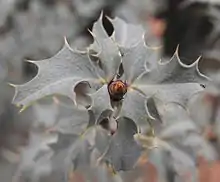Berberis haematocarpa
Berberis haematocarpa, Woot.[1] with the common names red barberry, red Mexican barbery, Colorado barberry and Mexican barberry, is a species in the Barberry family in southwestern North America.[2] It is also sometimes called algerita,[3] but that name is more often applied to its relative, Mahonia trifoliolata.
| Berberis haematocarpa | |
|---|---|
 | |
| Berberis haematocarpa shoot | |
 | |
| Berberis haematocarpa flower | |
| Scientific classification | |
| Kingdom: | Plantae |
| Clade: | Tracheophytes |
| Clade: | Angiosperms |
| Clade: | Eudicots |
| Order: | Ranunculales |
| Family: | Berberidaceae |
| Genus: | Berberis |
| Species: | B. haematocarpa |
| Binomial name | |
| Berberis haematocarpa Woot. | |
| Synonyms | |
|
Mahonia haematocarpa (Woot.) Fedde | |
Distribution
The shrub is native to the southwestern United States and northern Mexico at elevations of 900–2,300 metres (3,000–7,500 ft).[3] It grows on rocky slopes and canyons of mountains, in Pinyon-juniper woodlands, grasslands, and desert chaparral.[3] It is found on slopes and mesas in Arizona, New Mexico, Colorado, Texas, and Sonora.[2] It is also native to sky island habitats of the Mojave Desert in California and southwestern Nevada.[4]
Description
Berberis haematocarpa is a shrub growing up to 3–4 m (9.8–13.1 ft) tall, with stiff and erect branches.[3]
It has thick, rigid pinnate leaves of several centimeters long. Each is made up of a few thick 3-7 lance-shaped leaflets with very spiny toothed edges. They are a glaucus whitish-gray in color, due to a thick cuticle of wax.[3]
The inflorescences bear 3 to 5 bright yellow flowers, each with nine sepals and six petals all arranged in whorls of three.[3] The plant blooms from February to June.[5]
The fruit is a juicy, edible deep red to purplish-red berry, spherical and up to 8 mm (0.31 in) across.[3][6][7]
Uses
Native Americans of the Apache tribe used the plant's wood shavings for a yellow dye and as a traditional eye medicine, and it's fresh and preserved fruit for food.[13]
References
- Wooton, Bulletin of the Torrey Botanical Club 25: 304. 1898.
- "Berberis haematocarpa". Germplasm Resources Information Network (GRIN). Agricultural Research Service (ARS), United States Department of Agriculture (USDA). Retrieved 19 January 2018.
- Flora of North America @ efloras.org: Berberis haematocarpa
- Jepson eFlora (TJM2) treatment of Berberis haematocarpa
- Lady Bird Johnson Wildflower Center Native Plant Information Network (NPIN): Mahonia haematocarpa (Red barberry, Algerita, Red Oregon-grape)
- Laferriere, J.E. Berberidaceae, Barberry Family. Journal of the Arizona-Nevada Academy of Science 26:2-4. 1992.
- Flora of North America vol 3.
- USDA: Mahonia haematocarpa
- NatureServe Explorer.org: Comprehensive Species Report — Mahonia haematocarpa (Woot.) Fedde
- Loconte, H., & J. R. Estes. 1989. Phylogenetic systematics of Berberidaceae and Ranunculales (Magnoliidae). Systematic Botany 14:565-579.
- Marroquín, Jorge S., & Joseph E. Laferrière. 1997. Transfer of specific and infraspecific taxa from Mahonia to Berberis. Journal of the Arizona-Nevada Academy of Science 30(1):53-55.
- Laferrière, Joseph E. 1997. Transfer of specific and infraspecific taxa from Mahonia to Berberis. Bot. Zhurn. 82(9):96-99.
- University of Michigan at Dearborn: Native American Ethnobotany of Berberis haematocarpa
External links
- Calflora Database: Berberis haematocarpa (red fruited mahonia)
- UC Photos gallery: Berberis haematocarpa
| Wikimedia Commons has media related to Berberis haematocarpa. |